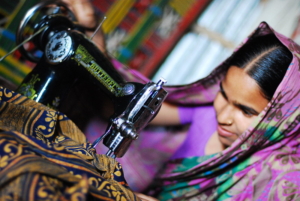Using Microfranchising to Reduce Poverty
 The World Bank estimates that one-third of the global population resides at the base of the economic pyramid (BOP), meaning they have an income of less than $3,000 in relative purchasing power. To put this into perspective, the median household income in the U.S. was $70,748 in 2021, meaning one-third of the population earns 95% less than the average family in the US. To combat this, businesses and community organizations around the world are turning to microfranchising to bolster household incomes in developing nations.
The World Bank estimates that one-third of the global population resides at the base of the economic pyramid (BOP), meaning they have an income of less than $3,000 in relative purchasing power. To put this into perspective, the median household income in the U.S. was $70,748 in 2021, meaning one-third of the population earns 95% less than the average family in the US. To combat this, businesses and community organizations around the world are turning to microfranchising to bolster household incomes in developing nations.
How Microfranchising Works
According to AllBusiness, a company that provides resources to small businesses, “Microfranchising is a business model that applies traditional franchising to very small businesses.” The microfranchising model involves two parties: the franchisor and the franchisee. The franchisor owns an established business and then creates a contract with the franchisee. The franchisee is paid by the franchisor in exchange for the franchisee’s work in distributing the franchisor’s services.
The Benefits of Microfranchising
In regions with high rates of unemployment, such as South Africa and Sudan, microfranchising is invaluable. Microfranchising not only allows individuals living in these areas the opportunity to earn money, but it also teaches soft and hard skills that can be used in their own future business ventures. Coined as a “short-cut to self-employment” by Thiruchelvam at Raconteur, this opportunity is the perfect way for those who do not usually have access to information on running a business to gain experience first-hand.
Microfranchising Successes
One successful company that has utilized microenterprising is The Clothing Bank (TCB). Having been established in 2011 in Cape Town, South Africa, the company has successfully made its way onto the list of Top 100 social impact companies. The company’s model has granted over 1,000 women and men in South Africa the opportunity to buy merchandise from various retailers operating in South Africa at a discounted price in order for them to then sell this for a profit. Along with the monetary benefit of the job, individuals will receive over 1,000 hours of training over a two-year period, teaching them how to run their own businesses.
Across the Atlantic Ocean in Haiti, similar tactics are being deployed. The Social Ventures Foundation (SVF), is attempting to improve the general quality of life of Haitians with the V’ice Haiti project. With over 6 million Haitians living below the poverty line, SVF considers all aspects of livelihood. Through providing donations to V’ice, your money will go towards funding equipment that Haitians will be able to use in order to become a franchisee. For example, V’ice’s “V’ike” scheme provides self-employment to young, at-risk males by supplying them with a bike and an attached food cooler. With this, the individuals are able to distribute clean water, vitamin-infused shaved ice and much more. This is consequently decreasing the unemployment rate while simultaneously reducing the number of Haitians who are vitamin deficient — which is currently standing at a staggering 80%.
Using Microfranchising to Reduce Poverty
Many charities are now following the example set by these impressive organizations to break the cycle of poverty. With ending poverty by 2030 in the number one spot of the UN Sustainable Development goals, it will be important that more charities implement this tried and tested method for improving lives across the planet.
– Christian Vince
Photo: Flickr
